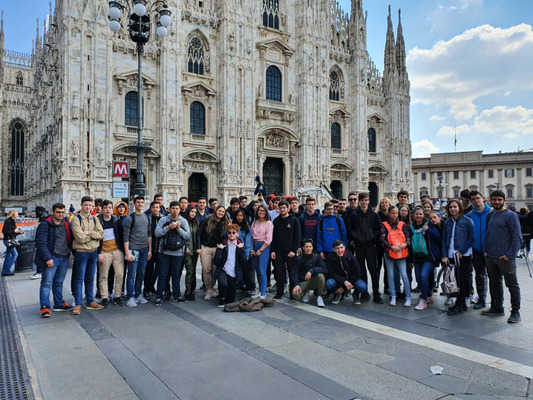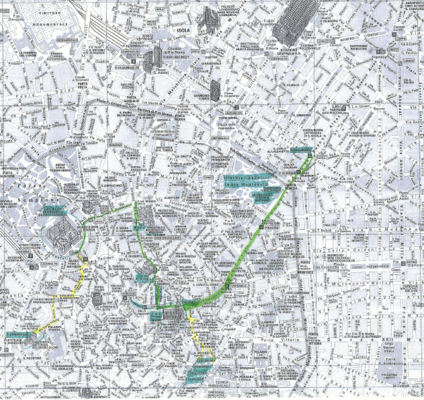
The city of Milan was founded by Celts in 590 b.C. with the name of Medhelan. It has been conquered by Romans in 222 b.C. and its name was changed in Mediolanum.
Many centuries later Milan became one of the capitals of the Roman Empire, under the government of Diocleziano. In 312 in Mediolanum was formuled the “ Costantino’s edict” that deals with the freedom of the christian populations.
In the XIV century Milan and his surroundings became a duchy “The duchy of Milan”, it was governed by the Sforza Family, who also builded “Castello Sforzesco” the Milanese castle. Leonardo Da Vinci worked for the Sforza too, in Milan in addition to his other masterpieces, he painted the Cenacle depicting the Last Supper of Jesus.
In March 1848, in the city there were “the 5 days of Milan” 5 days of rebellion ended with the momentary liberation from the Austrian government.
In the centuries Milan helped the Italian economy creating , with Genoa and Turin, the industrial triangle becoming one of the pins of the Italian economy.
In 2015, in Milan there were the “ World Exposition” the EXPO. Every year one of the most visitated events in Milan is the fashion week, an entire week dedicated at the catwalks.
Now Milan is considered one of the most beautiful cities in Italy and in Europe, it’s the centre of Italian economy and it’s conteplated like one of the capitals of fashion.
Public gardens Indro Montanelli
Public gardens Indro Montanelli, formerly known as Gardens of Venice’s portal, are a major and historic city park in Milan, located in the Porta Venezia district, north-east of the city center; they are the oldest city park in Milan. After their establishment, the Gardens have been repeatedly enlarged and enriched with notable buildings, most notably the Natural History Museum and the Planetarium.
In the second half of the 18th Century, the area of the Public Gardens was mostly cultivated land; a number of canals irrigated the area that were later closed. Several monuments and tourist attractions are enclosed within the park.
A statue of Indro Montanelli has been established in 2002, when the park was renamed after the popular journalist and writer, who was known to relax in the park every morning before entering the nearby offices of his newspaper. Montanelli was also shot in his legs by the terrorist group Brigate Rosse; his statue has been placed close to the spot where this happened.
La Scala
La Scala is an opera house in Milan, Italy. The theatre was inaugurated on 3 August 1778 and was originally known as the Nuovo Regio Ducale Teatro alla Scala (New Royal-Ducal Theatre alla Scala). The premiere performance was Antonio Salieri's Europa.
Most of Italy's greatest operatic artists, and many of the finest singers from around the world, have appeared at La Scala. The theatre is regarded as one of the leading opera and ballet theatres in the world and is home to the La Scala Theatre Chorus, La Scala Theatre Ballet and La Scala Theatre Orchestra. The theatre also has an associate school, known as the La Scala Theatre Academy (Italian: Accademia Teatro alla Scala), which offers professional training in music, dance, stage craft and stage management.
The previous theatre , the Teatro Regio Ducale, was destroyed on 25 February 1776, after a carnival gala. A group of ninety wealthy Milanese, who owned private boxes in the theatre, wrote to Archduke Ferdinand of Austria-Este asking for a new theatre and a provisional one to be used while completing the new one. The neoclassical architect Giuseppe Piermarini produced an initial design but it was rejected by Count Firmian (the governor of the then Austrian Lombardy).
A second plan was accepted in 1776 by Empress Maria Theresa. The new theatre was built on the former location of the church of Santa Maria alla Scala, from which the theatre gets its name. Also the square have the same name, in fact is the Scala square.
Vittorio Emanuele II Gallery
The Vittorio Emanuele II Gallery connects Piazza Duomo to Piazza della Scala. Due to the presence of elegant shops and premises, since its inauguration it was the meeting place of the Milanese bourgeoisie, so much so that it was dubbed the "salon of Milan." It is one of the most famous examples of European iron architecture.
It is often considered as one of the first examples shopping center in the world.
The design of this gallery belongs to the architect Giuseppe Mengoni and the contract was awarded to an English company.
Work on the construction of the tunnel began on 7 March 1865 and ended in 1877.
The Galleria of Milano is an example of a monumental building, in neoclassical and neo-renaissance style. The plane of the gallery has the shape of a cross; The structure is in masonry and the glass and iron roof and the interior is very colorful.
The gallery was also at the center of the technological innovations of the time and in its first period was lit by gas until the lighting of the gallery passed to electric lighting.
The life of the gallery was linked to that of the Teatro alla Scala: as well as a privileged transit point to go to the theater, the galleria Vittorio Emanuele II had become in a few years the gathering place for singers and musicians from all over Lombardy.
Today the Vittorio Emanuele II gallery is a shopping arcade with bars and shops inside.
Duomo di Milano
The construction of the Duomo di Milano started in 1386. It’s dedicated to Maria Nascente, the cathedral was commissioned by Gian Galeazzo Visconti.
It is the biggest Gothic building in Italy, made of pink-veined white marble. The golden statue of the Madonna, made by Perego, was placed on a pinnacle.
The central door represents stories from the life of Mary. There are a lot of pinnacles, statues (almost 3400) and decorations.
The interior shape is a Latin cross. The internal style is Gothic with the addition of classical elements like the main altar and the pulpit. In the crypt there is the chapel of Saint Carlo Borromeo and the saint's body. The result is a fusion of European Gothic style and Lombard tradition.
All the city of Milan can be seen from the roof terraces.
The Veneranda Fabbrica of Duomo di Milano is an ecclesiastical body with the purpose of worship and restoration. It includes also the Cathedral Museum and the library.
Map of Milan.
